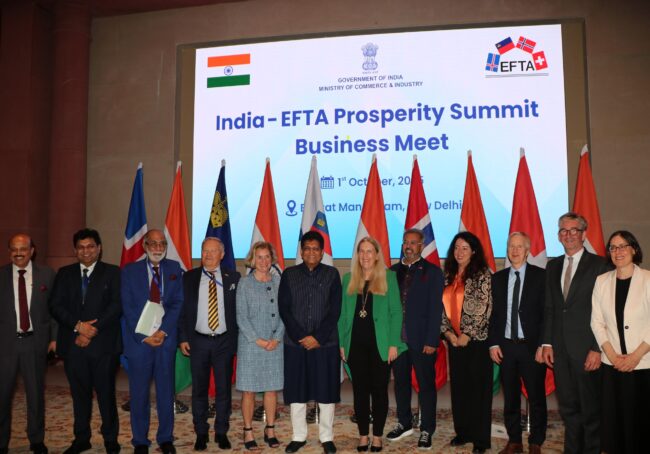
The recently signed Trade and Economic Partnership Agreement (TEPA) between India and the EFTA nations opens a gateway of opportunities for the Indian tooling sector. It promises tariff-free access to EFTA’s advanced markets, a clear roadmap for increased investment, and joint commitments to innovation and skill development. Effective from October 1, 2025, this landmark agreement aligns with the ambitions of ‘Make in India’ and ‘Aatmanirbhar Bharat’ and is poised to elevate India’s tooling sector onto the global stage.
Sanjay Chavre, Advisor, TAGMA India
When global trade landscapes shift, industries with vision and agility are prepared to seize the moment. The signing of the Trade and Economic Partnership Agreement (TEPA) between India and the EFTA nations, including Switzerland, Norway, Iceland, and Liechtenstein, marks such a moment for the Indian tooling sector. Announced on March 10, 2024, this landmark agreement, which came into effect on October 1, 2025, signals not just a new chapter in policy but a significant opening of markets, technology, and opportunities.
For India’s tooling manufacturers—long recognised as the silent strength behind the country’s dynamic manufacturing engine—TEPA represents a powerful catalyst for growth. With the promise of tariff-free access to EFTA’s advanced markets, a clear roadmap for increased investment, and mutual commitments that champion innovation and skill building, the stage is set for Indian tooling to step confidently onto the global platform. The agreement not only aligns with the ambitions of ‘Make in India’ and ‘Aatmanirbhar Bharat’ but also fuels collaboration and knowledge exchange, pushing the entire sector toward global standards of excellence.
This is more than a policy development; it’s the beginning of a new era for tooling in India—an era defined by expanded horizons, meaningful partnerships, and a renewed momentum for international success.
Indo-EFTA TEPA: An Overview
The Indo-EFTA TEPA is an extensive agreement encompassing 14 chapters that cover market access in goods and services, rules of origin, intellectual property rights, trade facilitation, investment promotion, and sustainable development commitments. This suite of provisions reflects a shared vision for enhanced cooperation and mutual benefit between India and the EFTA states.
Switzerland emerges as India’s largest trading partner within EFTA, closely followed by Norway. The agreement focuses on strengthening these ties through tariff reductions, investment promotion, and job creation, signalling a robust framework for economic collaboration.
Key Highlights of the Agreement
- EFTA has committed to promote investments with the aim to increase the stock of foreign direct investments by USD 100 billion in India in the next 15 years, and to facilitate the generation of 1 million direct employment in India, through such investments. The investments do not cover foreign portfolio investment.
- For the first ever time in the history of FTAs, a legal commitment is being made about promoting target-oriented investment and creation of jobs.
- EFTA is offering 92.2% of its tariff lines, which covers 99.6% of India’s exports. The EFTA’s market access offer covers 100% of non-agri products and tariff concession on Processed Agricultural Products (PAP).
- India is offering 82.7% of its tariff lines, which covers 95.3% of EFTA exports of which more than 80% import is gold. The effective duty on gold remains untouched. Sensitivity related to PLI in sectors such as pharma, medical devices & processed food, etc., have been taken while extending offers. Sectors such as dairy, soya, coal and sensitive agricultural products are kept in the exclusion list.
- India has offered 105 sub-sectors to the EFTA and secured commitments in 128 sub-sectors from Switzerland, 114 from Norway, 107 from Liechtenstein, and 110 from Iceland.
- TEPA would stimulate our services exports in sectors of our key strength/ interest such as IT services, business services, personal, cultural, sporting and recreational services, other education services, audio-visual services, etc.
- Services offers from EFTA include better access through digital delivery of Services (Mode 1), commercial presence (Mode 3) and improved commitments and certainty for entry and temporary stay of key personnel (Mode 4).
- TEPA has provisions for Mutual Recognition Agreements in Professional Services like nursing, chartered accountants, architects, etc.
- Commitments related to Intellectual Property Rights in TEPA are at TRIPS level. The IPR chapter with Switzerland, which has high standard for IPR, shows our robust IPR regime. India’s interests in generic medicines and concerns related to evergreening of patents have been fully addressed.
- India signals its commitment to sustainable development, inclusive growth, social development and environmental protection.
- Fosters transparency, efficiency, simplification, harmonisation and consistency of trade procedures.
- TEPA will empower our exporters with access to specialised inputs and create a conducive trade and investment environment. This would boost exports of Indian-made goods as well as provide opportunities for the services sector to access more markets.
- TEPA provides an opportunity to integrate into EU markets. Over 40% of Switzerland’s global services exports are to the EU. Indian companies can look to Switzerland as a base for extending its market reach to EU.
- TEPA will give impetus to ‘Make in India’ and ‘Aatmanirbhar Bharat’ by encouraging domestic manufacturing in sectors such as infrastructure and connectivity, manufacturing, machinery, pharmaceuticals, chemicals, food processing, transport and logistics, banking and financial services and insurance.
- TEPA would accelerate the creation of a large number of direct jobs in India for the country’s young aspirational workforce in the next 15 years, including better facilities for vocational and technical training. TEPA also facilitates technology collaboration and access to world-leading technologies in precision engineering, health sciences, renewable energy, innovation and R&D.
TABLE 1
Current Tooling Imports of EFTA Countries (in US$ Thousands, 2023)
| Tooling Code | Iceland (US$) | Norway (US$) | Switzerland (US$) |
| 820720 | 32,970 | 3,768,090 | 14,333,780 |
| 846610 | 524,640 | 12,278,070 | 95,396,920 |
| 848079 | 270,730 | 3,733,110 | 15,264,130 |
Note: For 2023, the top global importers in these tooling categories include the United States, European Union, Germany, and others, underscoring a vibrant and competitive global market.
The tooling codes mentioned in Table 1 are Harmonised System of Nomenclature (HSN) Codes. This system has been introduced for the systematic classification of goods worldwide. An HSN code is a 6-digit uniform code that classifies 5000+ products and is accepted worldwide. It was developed by the World Customs Organization (WCO) and came into effect in 1988.
These are some tooling-related HSN codes and key importers in 2023:
- HSN Code 820720: Die for Drawing or Extruding Metal
- Thailand ($109,081.40K, 3,996,300 Kg)
- United States ($94,323.10K, 2,420,500 Kg)
- European Union ($58,247.18K, 692,362 Kg)
- Germany ($45,363.41K, 914,335 Kg)
- Spain ($40,592.77K, 1,767,920 Kg).
- HSN Code 846610: Tool Holders and Self-Opening Dieheads
- United States ($1,022,896.29K, 7,900,230 Kg)
- European Union ($448,119.36K, 7,191,380 Kg)
- Germany ($341,363.28K, 5,865,730 Kg)
- China ($211,957.04K, 2,298,300 Kg)
- Italy ($195,728.63K , 8,138,380 Kg).
- HSN Code 848079: Moulds for Rubber or Plastics
- European Union ($271,514.62K, 12,748,600 Kg)
- United States ($265,634.86K, 6,293,090 Kg)
- India ($255,778.01K, 24,305,500 Kg)
- Vietnam ($196,125.62K, 4,680,560 Kg)
- Mexico ($141,879.51K , 3,355,410 Kg).
The World Trade Organization (WTO) plays a foundational role in establishing a robust, rules-based system for global trade, where member countries commit to legally binding agreements designed to foster smoother, more predictable, and freer exchange of goods and services. These agreements provide a comprehensive framework encompassing trade in goods, services, and intellectual property rights, encouraging tariff reductions, transparent policies, and effective dispute resolution. Integral to this framework is the HSN Code, a standardised classification that identifies and describes products with granularity, enabling accurate tracking of import-export data worldwide. This uniform coding system, largely adopted internationally except by select countries like the USA, facilitates seamless data sharing and analysis through global trade organisations, empowering manufacturers, exporters, and importers to navigate markets confidently and capitalise on emerging opportunities.
Opportunities for the Indian Tooling Sector under Indo-EFTA TEPA
One of the most promising aspects of this agreement is zero import duty on all non-agricultural products, including tooling exports from India to countries such as Iceland, Norway, and Switzerland. Conversely, India will phase out tariffs on tooling imports from EFTA over 7 to 10 years, facilitating a balanced and gradual opening of markets.
| Tooling Code | Iceland / Norway (Import Duties) | Switzerland (Import Duties) |
| 8207 | Duty eliminated immediately from Oct 1, 2025 (EIF) | Duties phased out over 7 years, duty-free from 2032 (E7) |
| 8466 | Duties phased out over 10 years, duty-free from 2035 (E10) | Duties phased out over 10 years, duty-free from 2035 (E10) |
| 8480 | Duties phased out over 10 years (E10) | Duties phased out over 7 or 10 years (E7 / E10) |
Understanding Rules of Origin (RoO) and Their Function
Rules of Origin play a crucial role in ensuring that the benefits of FTAs accrue only to products genuinely originating from the partner countries. They:
- Enable preferential tariff treatment.
- Help enforce trade policies, such as anti-dumping and safeguard measures.
- Prevent transhipment and tariff evasion through third countries.
- Aid customs authorities in smooth administration and compliance.
TABLE 2
India-EFTA Rules of Origin for Tooling: Liberal and Industry-Friendly
| Tooling Code | RoO Requirements |
| 8207 | CTH or VNM 50% |
| 8466 | CTSH or VNM 60% |
| 8480 | CTSH or VNM 60% |
Abbreviations explained:
CTH (Change in Tariff Heading) isa change in tariff classification at the four-digit level, indicating significant value addition.
CTSH (Change in Tariff Subheading) isa deeper change at the six-digit level, signifying more detailed transformation.
VNM (Value of Non-Originating Materials) are limits on the percentage of non-origin materials used, e.g., VNM 60% means non-origin materials do not exceed 60% of the product’s value.
Conclusion
The Indo-EFTA Trade and Economic Partnership Agreement signifies a strategic advancement for India’s tooling industry—poised to leverage comprehensive market access, investment inflows, and technology upgrades. With tariff reductions, liberal rules of origin, and enhanced service commitments, TEPA stands as a catalyst for India’s aspiration to emerge as a global tooling hub. Coupled with the proactive role of bodies like EEPC India and participation in international trade platforms, the agreement sets the stage for a transformative growth trajectory for the Indian tooling sector, aligned with the broader goals of ‘Make in India’ and ‘Aatmanirbhar Bharat’.
Indian tooling manufacturers and exporters are encouraged to harness these opportunities, fostering innovation, scaling capacities, and expanding global footprints, thereby contributing to India’s robust manufacturing and export ecosystem.

About the Author
Sanjay Chavre is Advisor to TAGMA India.
A respected technocrat and policy strategist, Mr. Chavre has been a pivotal figure in the evolution of India’s manufacturing and tooling ecosystem. With decades of experience at the intersection of government and industry, he has contributed to the development of forward-looking policies that promote indigenous technology, strengthen domestic capabilities, and uplift MSMEs within the tooling and precision engineering sectors.
Mr. Chavre has held key roles in various government departments. He has been instrumental in formulating and executing initiatives that align with India’s long-term vision for industrial growth and self-reliance. His expertise lies in enabling public-private collaboration, fostering innovation ecosystems, and building frameworks that support sustainable industrial development.
In his current role as Advisor to TAGMA India, he continues to guide efforts aimed at enhancing the global competitiveness of Indian toolmakers. His insights have been vital in positioning the Indian tooling industry as a reliable and technologically advanced partner in the global supply chain.




COMMENTS